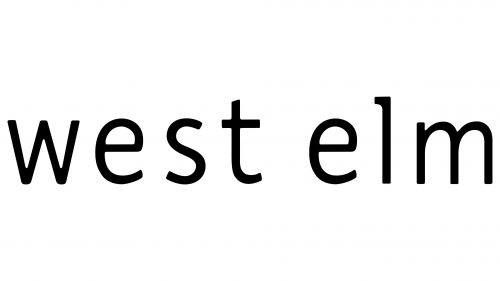The West Elm logo emphasizes the simplicity and refined clarity inherent in modern style. It radiates a sense of home comfort that can easily be achieved with the company’s interior items and furniture. Simplicity and functionality are at the core of the brand’s concept, reflected in the visual symbol’s minimalist design. Every detail of the emblem conveys the idea of convenience and aesthetic harmony, helping customers create a space where comfort and style coexist.
West Elm: Brand overview
West Elm’s history began in 2002 when Williams-Sonoma, Inc., already well-known for its Pottery Barn and Williams-Sonoma brands, launched a new line of furniture and home goods aimed at young, urban consumers. The goal was to offer modern design at affordable prices, bridging the gap between high-end designer labels and mass-market brands.
The brand was created to reflect the style of contemporary urban life by combining good design with practicality. The American elm tree symbolized strength and resilience, and Brooklyn, New York, where the first store was located, inspired the name.
In 2002, the company introduced its first catalog, which included a small selection of home goods. Initially, the company operated as an online store and catalog, testing the market before gradually expanding its product line. The first physical store opened in Brooklyn in 2003, offering customers a chance to experience the brand in person. The store was designed to inspire customers to create unique spaces by providing ready-made solutions and design ideas.
The business steadily grew over the next few years, opening stores in major U.S. cities. The brand quickly gained popularity among young professionals and families who appreciated affordable modern design.
A major turning point came in 2006 when the company began collaborating with independent designers and artisans. These partnerships allowed the brand to offer unique, limited-edition collections that helped set it apart from competitors and attracted customers looking for something special.
Despite the global financial crisis in 2008, the company continued to expand. The business responded to the changing economy by offering more affordable product lines without sacrificing style or quality. This strategy not only helped weather the downturn but also strengthened its reputation.
In 2010, the company launched its first office furniture collection, marking an effort to enter new markets and meet the growing demand for stylish yet functional workspaces.
In 2011, the brand focused on building its social media presence, especially on platforms like Pinterest and Instagram. This allowed the company to connect with its target audience more effectively by showcasing its products in real-life settings and encouraging customers to share their design ideas.
International expansion began in 2013, starting with stores in Canada and Australia. To succeed in these new markets, the company adjusted its product offerings and marketing strategies to suit local tastes and preferences.
2014, the company launched the LOCAL initiative to support local makers and artisans. This program expanded the range of unique products and helped the brand build stronger ties with communities where its stores were located.
In 2015, the company introduced Workspace, a complete collection of office furniture and accessories developed in collaboration with ergonomic experts. This launch marked its successful entry into the commercial furniture market.
The brand announced plans in 2016 to open a chain of hotels designed entirely in its aesthetic. While the hotel concept was never fully realized, it demonstrated the company’s ambition to expand beyond traditional retail.
In 2017, the business launched a line of furniture and accessories for children’s rooms. This expansion reflected the growing demand for stylish, functional furniture for families.
In 2018, the company revamped its website, enhancing interior visualization tools and offering personalized recommendations to improve the online shopping experience, which had become increasingly important in the competitive retail landscape.
In response to the growing sharing economy trend, the company introduced a furniture rental service in 2019 aimed at young professionals who move frequently or prefer short-term living arrangements.
Despite global challenges in 2020 and 2021, the brand adapted to changing customer needs by expanding its virtual interior design services, strengthening its online presence, and offering enhanced contactless delivery options.
International expansion continued in 2022, opening new stores across Europe and Asia. The company also collaborated with renowned designers, launching exclusive collections that helped solidify its position as a leader in modern interior design.
The business has consistently evolved with shifting consumer preferences and design trends. From its beginnings as a small online retailer to becoming a global brand, the company has expanded its offerings and reach while staying true to its mission of providing stylish, modern products at accessible prices.
Meaning and History
What is West Elm?
This home goods retailer’s unique combination of mid-century design principles and modern elements transforms living spaces. The Brooklyn-based company caters to stylish customers who seek to add distinctive handmade elements to their homes. The assortment includes carefully curated furniture, decor, and accessories that reflect collaborations with independent designers and artisans, giving mass-produced items a personal, handcrafted character. The brand offers a variety of products—from fabrics and tableware to statement lighting and stylish sofas—helping customers create unique, cohesive interiors. In addition to retail, the company hosts workshops and provides design services, inspiring buyers to become independent interior stylists.
2002 – today
The West Elm logo embodies the idea of everyday simplicity. Every element is designed to create a sense of minimalism and naturalness, perfectly aligning with the company’s philosophy of producing furniture and decor for daily use. The thin, even lines of the font symbolize purity and lightness, free from unnecessary details. The minimalist style supports the brand’s overall concept, which offers products to create a cozy and functional space at home.
The gray color chosen for the logo echoes modern interiors, where metallic elements and restrained palettes are often used. This reflects the company’s connection to contemporary style, which focuses on simple forms and natural materials. Gray symbolizes neutrality and versatility, making the brand’s products suitable for any home.
The company name, “West Elm,” refers to its origins when the first store opened in the west of New York. The choice of “Elm,” a type of tree, in the name emphasizes the focus on using natural materials. It also points to the company’s commitment to balancing modern design with traditional natural materials, making the brand’s furniture and decor stylish and eco-conscious.
The West Elm emblem represents a harmonious blend of simplicity, naturalness, and minimalism—values at the core of everything the brand offers.





